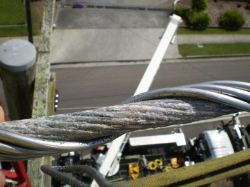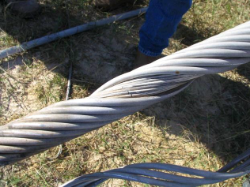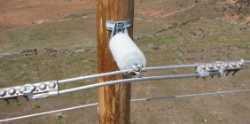Restoring electrical integrity to the network
15 Jan, 2018
Restoring electrical and mechanical integrity to damaged conductor at suspension clamps
By Corey Scott
As our electrical network infrastructure continues to age, utilities are increasing the inspection frequency of lines and connectors with the goal of preventing outages and conductor breakages. The use of infra-red, LIDAR and UV inspection technologies allows utilities to identify and prioritise maintenance tasks better than ever before. A commonly identified issue is conductor damage at suspension clamps, where broken strands create a weakened electrical and tensile strength of the conductor.
Conductors in our transmission network are constantly exposed to differing forces by our weather. In particular, wind induced movement can create low frequency, high amplitude movement in the case of conductor galloping during high winds, or higher frequency, lower amplitude movement known as aeolian vibration. The forces generated at connectors and hardware connections during these phenomena causes damage to the conductors in the form of strand fatigue eventually leading to strand breakage. The current will not cross the break, and therefore must be transferred to strands which are still intact. Obviously, once several strands are broken, the current concentration on the remaining strands causes them to heat up. If the problem is not addressed, this increased heat anneals the remaining stranding, weakening it substantially, and it is already overloaded as it is carrying the mechanical load of the entire conductor.
These phenomena are relatively common and require hardware mitigation strategies to prevent the possibility of conductor fatigue, particularly at suspension clamps and deadends. The use of vibration dampers to mitigate the effects of aeolian vibration, and armour rods to reinforce the conductor at suspension clamps are effective methods. However, for lines that are using incorrect dampers (or where they have never been installed or have been damaged or installed at the wrong location) and where conductor fatigue has already occurred, the only available option has been to replace the damaged section of line.
The cost of this remediation work is substantial and the scope of this maintenance task is significant in magnitude. It involves lifting the conductor from the suspension clamp, attaching mechanical grips a reasonable distance out on each span, typically 10+ meters in each direction, cutting a portion of conductor out, and using two splices, install a new section of conductor in its place, and replace it in the suspension clamp. At the least, it requires lifting the conductor and using an armour rod to reinforce the damage if it has only a few broken strands, typically less than 20%. This then requires a new, larger suspension clamp which will house the now increased diameter. Unfortunately, a lot of strand damage has been discovered underneath armour rods, or armour grip suspension units, and at that point, replacing the rods or AGS unit will simply not suffice.
AAAC conductors are commonly used in Australia and New Zealand as they can be strung at long spans relative to ACSR conductors. AAAC conductor is more prone to damage at suspension clamps when strung at long spans under higher tensions. The common cause of damage occurs on the conductor at suspension clamp contact surfaces under load, referred to as fretting. This contact point wear results in material degradation and the concomitant debris is prone to oxidise. With prolonged conductor vibration and bending at a fixed point, fatigue of the conductor strands will occur (even under helical wraps), and these broken strands reduce the conductors current carrying and tension capabilities.
ClampStar® provides an elegant, economical and easily installed solution for restoring the electrical and mechanical integrity of conductors already damaged without the need for costly re-stringing. The ClampStar® shunts provide an excellent solution for PERMANENT mechanical and electrical remediation and upgrade to existing damaged conductor at suspension clamps. Safe-T-Link Tether assemblies are available for deadend and suspension clamp applications requiring additional mechanical support where the tensile strengths of the conductor have been compromised.
Each unit is prefilled with proprietary CC² inhibitor to prevent galvanic corrosion and is designed with an integral fastening assembly that provides a high conductivity path and incorporates flat and Belleville washers to maintain compressive force regardless of thermal contraction and expansion. Installing a ClampStar® over the entire suspension assembly, including rods, provides assurance that the entire electrical and mechanical load will be maintained indefinitely.
As a maintenance solution, ClampStar® provides great benefit to the utility:
- Lightweight design installs in less than 10 minutes!
- Permanent installation for deadends, inline splices, suspension clamps, OPGW and damaged conductor
- Easily installs over existing connectors or suspension points
- No rigging equipment required such as special mechanical grips, Come-Alongs, jumpers or cutters
- Can be installed with hot stick or barehand methods
- Available for copper, composite core and all aluminium stranded conductors
For more information on ClampStar® products and how they can be utilised in a variety of different applications, contact Corey Scott of TEN Group to find out more.
|



|





